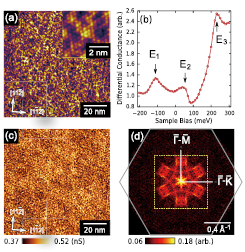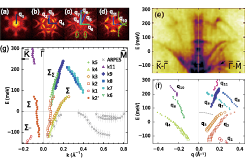Scanning Tunneling Spectroscopy Study of Quasiparticle Interference on Dual Topological Insulator Bi1-xSbx
F. Komori, I. Matsuda, and Y. Ando
Three-dimensional (3D) topological insulators (TIs) are characterized by a nontrivial topological invariant, which is protected by symmetry and the presence of a bulk band gap [1]. So far, two types of topological invariants have been found to be useful for finding 3D TIs. One is called Z2 index and the other is mirror Chern number. A nontrivial Z2 topology of the bulks state gives rise to spin-polarized metallic surface sates, which are protected by time-reversal symmetry. A nontrivial mirror Chern number defines a 3D topological crystalline insulator, which is associated with metallic surface states protected by mirror symmetry of the crystal and robust against TRS breaking. Insulators belonging to both of the topological phases may be called “dual” TIs. Bulk BiSb alloy is well known as a 3D Z2 TI for x ~ 0.1-0.2, and this material has actually been predicted to be a dual TI. Although the electronic structure of the occupied surface states in BiSb has been well studied by means of angle-resolved photoemission spectroscopy (ARPES) [2], the structure of the whole surface bands including the unoccupied states has not been observed in pristine samples.

Fig. 1. (a) STM image of a region (93 x 93 nm2) on a clean surface of Bi1-xSbx obtained at a constant current mode. (Setpoint: It =200 pA at Vb = 500 mV) The inset shows the close up image of a region (5 x 5 nm2) revealing the hexagonal lattice of surface atoms. (Setpoint: 500 pA at 500 mV) (b) Average of 256 x 256 tunneling spectra measured on the same region. The peaks at E1, E2, and E3 are the van Hove singularities related to the surface bands. (Bias modulation: 7 mVrms at 396 Hz; Setpoint: 500 pA at 500 mV) (c) Spatial mapping of dI/dV at Vb = +80 mV of the same region. (d) FT image calculated from the dI/dV in (c). All the equivalent points are averaged to increase signal-to-noise ratio. The hexagon represents the size and the orientation of the surface Brillouin zone. The dashed square represents the area displayed in the FT images in Fig. 2(a)-(d).

Fig. 2. (a)-(d) Fourie-transformation (FT) of dI/dV maps at E = -140 (a), -40 (b), +160 (c), and +260(d) meV on a clean surface of Bi1-xSbx. The scattering vectors corresponding to the observed FT peaks are labeled by q1-q11. (e) Profiles of the FT images in the Γ-M and the Γ-K directions plotted in grayscale. The arrow at around -100 meV in the Γ-M direction indicate an artifact which disappears in the FT of (dI/dV )/(I/V ) maps. (f) Peak positions of the FT profiles. The size (area) of each marker is proportional to the peak intensity. Dashed line around 70 meV is a possible FT peak corresponding to QPI within the pocket along Γ-M, but not analyzed in detail. (g) Surface band structure of the clean surface of Bi1-xSbx reconstructed from our QPI data. Previous ARPES data [3] with an energy resolution of 18 meV are also plotted.
Measurements of the quasiparticle interference (QPI) using the Fourier-transform scanning tunneling spectroscopy (FT-STS), as shown in Fig. 1, is useful for elucidating the mirror Chern number of the BiSb alloy from the whole band structure [3]. The BiSb alloy would be suitable for the studies of both the spin texture and the change caused by surface magnetic impurities because the disorder in the electrostatic potential due to the alloying gives rise to QPI on the pristine surface. We clarified the dispersions of the unoccupied electronic states via the analysis of the QPI on the clean cleaved surface of BiSb as shown in Fig. 2. The absence of band crossing between Σ1 and Σ2 was elucidated, and the mirror Chern number is unambiguously determined to be -1. Co atoms deposited onto a clean surface lead to the appearance of clover-leaf-like impurity states at around 80 meV above EF. In spite of the deposition of the Co atoms on the surface, the results of QPI show no significant changes in the band dispersion from those for the clean surface. An enhancement of spin-conserving scatterings was detected through stronger QPI peaks in the FT spectrum.
References
- [1] for review, Y. Ando, J. Phys. Soc. Jpn. 82, 102001 (2013).
- [2] F. Nakamura, et. al. , Phys. Rev. B 84, 235308 (2011).
- [3] S. Yoshizawa et. al., Phys. Rev. B 91, 045423 (2015).
